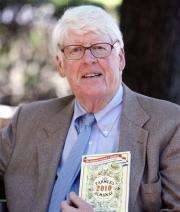'Old Farmer's Almanac' still spots cold in Web age

(AP) -- Doris Smith Mills often comes across past editions of the "Old Farmer's Almanac" lying around her family's 110-year-old Westport, Mass., farm. She believes previous Smiths read it for entertainment and its yearly weather predictions to ready for New England's fickle climate changes.
Today, the 78-year-old has the 24-hour Weather Channel and various weather Web sites at her fingertips, and her farm has technology to handle all sorts of extreme weather. But she still reads the Dublin, N.H.-based almanac because it's been reliable for generations, she said.
"It helps us prepare," said Smith, whose family owns Noquochoke Orchards along the Westport River. "It's interesting. I like reading it."
Despite the accessibility of forecasts that rely more heavily on traditional science, the 218-year-old "Old Farmer's Almanac" and its longtime New England competitor, the Maine-based "Farmer's Almanac," still draw droves of fans. The books, which predict weather based on sunspots, planetary positions and meteorology, still are popular at farmers markets and bookstores. Each has a circulation of 3.5 million, and their Web sites are stacked with videos, blogs and podcasts.
"Old Farmer's Almanac" Editor Janice Stillman said her publication, the latest edition of which was released this week, is even looking into creating an iPhone application. "We've always been state of the art since 1792," Stillman said.
Based on their own calculations, both almanacs are predicting a colder-than-usual winter. That conflicts with the long-range forecast by the National Weather Service, which is calling for warmer-than-normal temperatures across much of the country because of an El Nino system in the tropical Pacific Ocean, said Mike Halpert, deputy director of the NOAA Climate Prediction Center in Camp Springs, Md.
The "Old Farmer's Almanac" also predicts a cooler summer and says a major hurricane will hit Florida next September. Stillman said upcoming solar activity, such as sunspots, are one of the factors in the almanac's predictions.
John Nielsen-Gammon, an atmospheric science professor at Texas A&M University, said predicting long-range weather is a challenge for scientists and laymen alike. But El Nino and La Nina systems have proven to be good indicators of what to expect, he said.
"There is no known evidence that sunspots have but a small effect on the earth's climate," said Nielsen-Gammon. "And we're talking about a couple of tenths of a degree Celsius difference."
Still, Judson Hale, the semiretired chairman and longtime pitchman for the "Old Farmer's Almanac," said there have always been almanac doubters. Hale, 76, said the almanac uses a combination of science and a "secret formula" created by founder Robert B. Thomas. That combination, Hale said, has produced what he calls an "80 percent accuracy rate" in predicting long-range weather.
The secret formula, according to the almanac's Web site, is kept in a black box that is locked away in the New Hampshire offices and can only be accessed by a handful of employees.
Besides its weather predictions, the "Old Farmer's Almanac" also is known for its quirky stories and advice tidbits. For example, in the 2010 edition, the almanac advises readers on how to prevent their suitcases from collecting an odor when traveling. It advises travelers to put their socks and underwear in plastic bags and place the bags inside their shoes. Then put the shoes inside old, clean socks before packing them in the suitcase.
Hale admits the "Old Farmer's Almanac" has been viewed by some as a "bit hokey." He suspects that might explain how he ended up sharing the spotlight with certain guests at some of his media appearances. Many years ago, he appeared on a Cleveland television show next to a guest who could play "America the Beautiful" with his armpit and another guest who was said to be the world's tallest woman, he said.
"I just tried to be dignified," Hale said. "But I've often thought, 'Was there a message in all these groupings?' And if so, what was the message?"
There also have been odd coincidences. In 1978, a scheduled appearance on ABC's Good Morning America was canceled when Pope Paul VI died. When the show rescheduled Hale months later, his appearance was canceled again. The new pope, John Paul I, had died.
©2009 The Associated Press. All rights reserved. This material may not be published, broadcast, rewritten or redistributed.

















